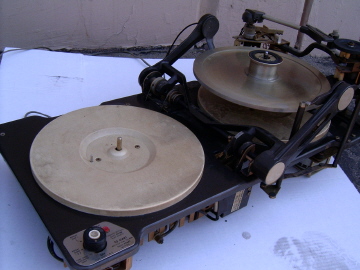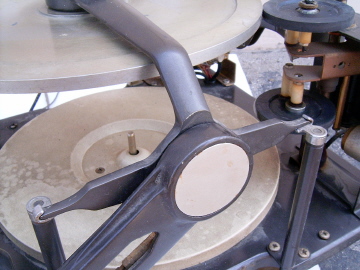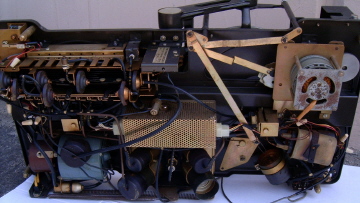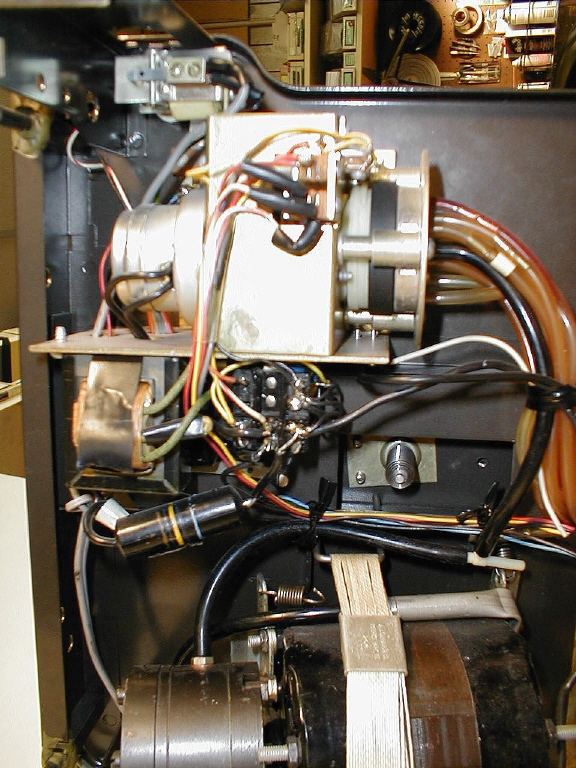The Lincoln Series
50 Turn-Over Pneumatic Record Changer
Produced by the
Lincoln Engineering Co. in St. Louis, Missouri.
These famous turn-over
changers, including the LP-only Series 60 Fisher-Lincoln
changer, were produced from 1949 to 1965.
In the mid-50s the Lincoln changer was often used as a
replacement for a Capehart turn-over changer, and Lincoln
produced a special model, the 51 and 51M changer to fit into
a Capehart cabinet. This provided the Capehart owner with a
quick (but expensive) possibility to upgrade the Capehart to
33 rpm and 45 rpm microgroove record capability.
Changers for commercial use (double capacity vacuum
reservoir) were offered as well.
This unique machine had a couple of appealing features: 3
speed design for 78, 45 and 33 rpm records. Ability to play
both sides of the record. A true intermix changer - any size
record will be played correctly. The large size of the
magazine allows to play a large number of records - 20 or
more - on both sides without interruption. That equals up to
3 hrs playing time for 12" 78 rpm, or a staggering 16 hrs
for LPs !
This is accomplished by the use of a vacuum pump which
powers all movements of the turntable, transfer arm and tone
arm. It also holds the record on a suction cup in
upside-down position for the B-side playing. The changer is
able to play LPs for up to 30 minutes with no loss of vacuum
suction. The vacuum pump only operates during the change
cycle to refill a reservoir.
Some vital statistics:
- operating vacuum 15 inches mercury
- 7 vacuum pistons
- 2 suction cups
- 3 electric motors
- 1 vacuum pump
- a cam manifold with 7 cams and 7 independent valves, 2 of
which also double as electric switches.
- 2 big idler wheels
- speed selection: 78, 45, 33 rpm and a neutral gear
- 1 gravity powered check valve.
- 1 pneumatically actuated pneumatic - electric relay
- 2 pneumatic electric switches
While a
sound design, most surviving Series 50 changers are now
non-operational, because the rubber in the suction cups and
bellows has hardened and cracked.
MACHINE INFORMATION
|
Maker |
Lincoln
Engineering Co |
|
Model |
Series 50
Changer |
|
Year |
1952 |
|
Owner |
Carsten
Fischer |
|
Repaired/Serviced by |
Carsten
Fischer |
|
Idler Wheel
Resurfaced |
Ed Crockett |
The
Fisher-Lincoln Series 60 Turn-Over Pneumatic Record Changer
While the Series 50
changer was a reliable workhorse, the need for constant
vacuum suction during the play of the record could lead to
dropped records if the label had some scratches or a
sticker.
In 1961 Fisher proudly presented the updated Series 60
Fisher-Lincoln Turn-Over Turntable.
 
This changer, while
keeping the basic idea of a vacuum-powered mechanism, had
the following design changes:
- 33 rpm / 45 rpm with automatic size intermix and speed
change (a
7" record automatically
changes the speed to 45 rpm)
- The turntable also
works as a transfer arm: The whole turntable moves to the
left to pick up a record, locks into playing position, moves
to the right for depositing the record.
- The turntable does not need suction during the play of the
record: The record is held by a rubber "boot"
in the spindle hole during play. Therefore, dropped records
due to air leaks are avoided.
However, as great as this machine looked, it was a disaster
for all involved.
As a collector, whose father acquired a Series 60 new, told
me:
This changer never
worked correctly. Fisher sent one repair man after another,
with no improvement.
The embarrassment was such that Fisher would hide the Series
60 changer and not promote it at audio shows.
The reason for the lack of reliability lies here:

Underside of
the Series 60:
"Rack"
Assembly Pistons:
lock linkage turntable motor
for turntable turn over
starting capacitor
Vacuum Pump for turntable arm
While every record
changer ever built uses some kind of a central cam to
coordinate movements, the Series 60 was a radical departure
from this concept:
Instead of a
cam-regulated mechanism, the 60 is a step-by-step design:
After each movement (for example the record pick-up) some
moving part hits a pneumatic switch, which then will trigger
the next movement.
The mechanism is coordinated by the "rack assembly" in the
upper left quadrant of the picture, where the impulse by the
pneumatic switch causes a rubber bellow to collapse, which
in turn pulls one of many slats inside the rack assembly,
which then triggers another valve for the next step.
It is as complicated as
it sounds, and does not work.
MACHINE INFORMATION
|
Maker |
Fisher-Lincoln |
|
Model |
Series 60
Changer |
|
Year |
1961 |
|
Owner |
Robert
Baumbach |
| |
not
operational |
The Fisher-Lincoln
Series 70 Turn-Over Pneumatic Record Changer
After the utter disaster
of the Series 60 changer, Lincoln removed the malfunctioning
rack assembly and inserted a traditional motor-driven cam
assembly that powered the valves for the mechanism.

This was offered as a
"fix" to disappointed Series 60 customers, but few must have
taken Lincoln up on this offer.
I have only ever seen one Series 70 machine.
In all other respects of the mechanism and the upper works,
the Series 70 is identical to the Series 60 changer.
The Series 60 failure caused a quick end for the whole line
of Lincoln pneumatic changers, which quickly disappeared
from the market, as well as from commercial and private use.
I am always interested
to hear about other machines.
If you want to get in
touch with me, or are interested in a quality reproduction
of the 1952 Lincoln Series 50 Changer Service manual (141
pages, 21 diagrams, 3 fold out double sided diagrams) or a
1961 Fisher-Lincoln Series 60 manual, please send me an
e-mail at:
You can reach me at:
sgimips1"at"yahoo.com
(replace "at" with @)
Again my great thanks to
Chuck Azzalina for his great help in creating these pages.
Pleases check out his
other web pages
with even more fascinating early audio and TV tube
electronics. One level above this page, you can find more
fascinating changers with video clips.
My thanks also to Robert Baumbach who provided many
pictures and access to the Series 60 changer.
MORE VIDEOS and LINKS
Another video of the Lincoln Series 50 above on Robert
Baumbach's great site of Old Record Changers at:
www.oldrecordchangers.com
|
